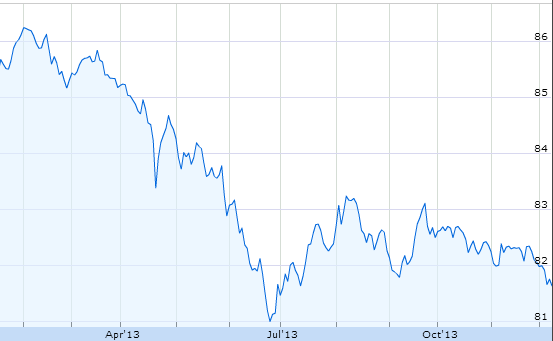The US banking sector continues to outperform the broader market. Furthermore, for the first time this year, regional bank shares are outperforming the overall bank index, which is driven primarily by the largest banks.
| Red = S&P500; Green = S&P total banking sector index ETF; Blue = S&P regional banks index ETF |
The key reason for the strong performance among US banks remains the steepening treasury curve. Banks pay next to nothing on deposits while charging a rate that is often linked to treasuries on the loans they make. The steeper the curve, the wider the “margin”. And given the leverage inherent in the banking system, even a small margin increase materially improves the return on equity.
The treasury curve has been steepening sharply in recent weeks – as seen from the spread between the 10y and the 2y yields (as well as 30y and 2y).
What’s driving this steepening? Historically, rising longer dated bond yields were caused by higher inflation expectations. That’s not the case this time around. In fact as the chart below shows, longer-term inflation expectations have been declining.
 |
| Dow Jones Credit Suisse 10-Year Inflation Breakeven Index |
The rise in yields is instead mostly driven by higher expectations of earlier and faster reductions in securities purchases by the Fed. In particular, some at the Fed have been happy to see a bit of stabilization in monthly payrolls growth (at around 200K).
The sustainability of this trend is yet to be proven, but combined with better GDP figures (see chart) and improved new home sales (see chart), these data may be sufficient to push even this dovish FOMC into launching its exit sooner than expected. The fact that corporate spreads are at the levels not seen since 2007 (see post) doesn’t help the case for maintaining the current pace of QE either.
At the same time, Bernanke was quite clear that it will be some time before the Fed will begin pushing up short-term rates – even after QE ends. We therefore have the short-term rates (and therefore bank deposit rates) remaining near zero, while longer term rates rising due to expectations of taper. This is resulting in significant curve steepening, a great environment for banks.
The next question is why all of a sudden we are seeing regional banks outperforming the overall banking sector. The answer has to do with the changing regulatory landscape, as the Volcker Rule is about to go into effect.
WSJ: – Barring a last-minute surprise, the votes will result in tighter restrictions on certain trading activities that go beyond what regulators had agreed to just a few weeks ago, according to people familiar with the matter. Since then, regulators have been locked in tense negotiations that threatened to upend the provision.
Under the final rule, regulators are expected to closely track trading activities with an eye on whether certain trades known as hedges are designed to post a profit rather than offset risks that accompany trading with clients. The finished version of the Volcker rule is likely to require that hedges be designed to reduce specific risks, according to a portion of the proposed rule reviewed by The Wall Street Journal.
Hedging activity should shrink or alleviate “one or more specific, identifiable risks” such as market risk, currency or foreign-exchange risk, and interest-rate risk, the language says.
“This is the new era of Big Brother banking,” said Michael Mayo, an analyst with CLSA Americas. “Now banks’ fortunes are more closely tied to the government.”
This “Big Brother banking” will have a far greater effect on the largest financial institutions than on the regional or smaller banks. The inability to trade in “prop” accounts is already resulting in reduced liquidity and weaker market making capability among the larger banks. Often in the US bond markets (excluding treasury/agency bonds), banks already do little more than act as “introduction brokers” for a quarter-point spread. All this is resulting in declining “sales & trading” revenue for the largest banks.
Bloomberg: – The $44 billion at stake represents principal trading revenue at the five largest Wall Street firms in the 12 months ended Sept. 30, led by New York-based JPMorgan, the biggest U.S. lender, with $11.4 billion. An additional $14 billion of the banks’ investment revenue could be reduced by the rule’s limits on stakes in hedge funds and private-equity deals. Collectively, the sum represents 18 percent of the companies’ revenue.
Not facing these same headwinds, regional banks are now outperforming.